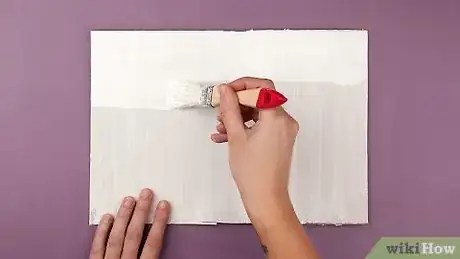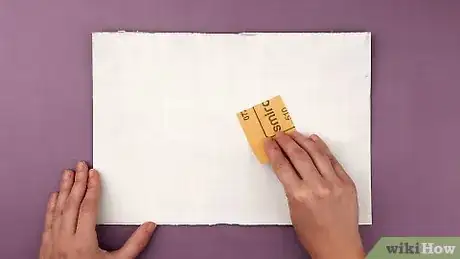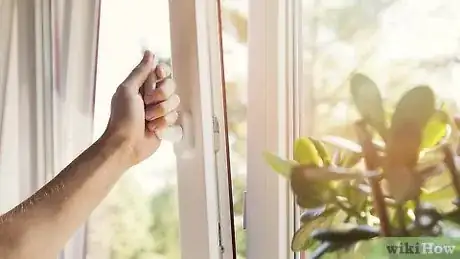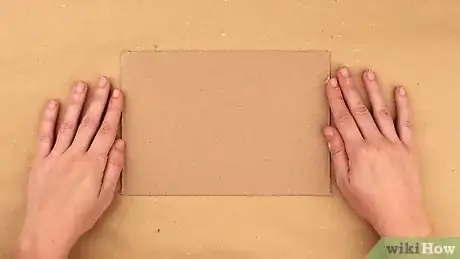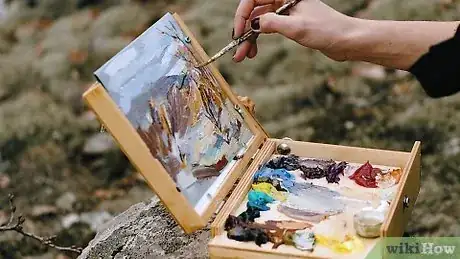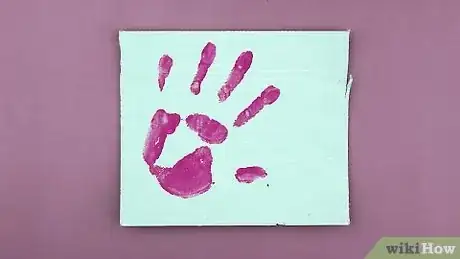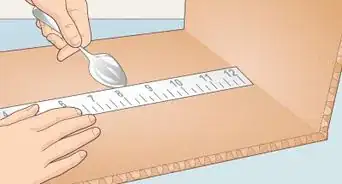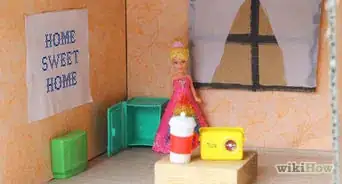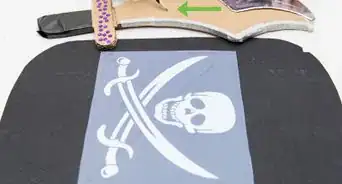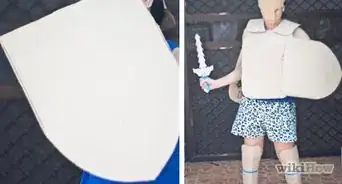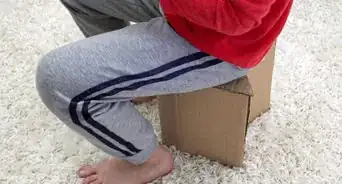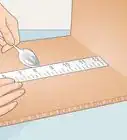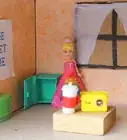This article was co-authored by wikiHow Staff. Our trained team of editors and researchers validate articles for accuracy and comprehensiveness. wikiHow's Content Management Team carefully monitors the work from our editorial staff to ensure that each article is backed by trusted research and meets our high quality standards.
There are 12 references cited in this article, which can be found at the bottom of the page.
The wikiHow Video Team also followed the article's instructions and verified that they work.
This article has been viewed 209,358 times.
Learn more...
Cardboard is a great material to paint on since it’s so sturdy and affordable. Whether you want to paint the entire cardboard piece or create cardboard art, you should first prime the surface to get the best colour possible. Then, to keep the cardboard from warping, apply multiple thin coats, and dry the coats as well as possible. In no time, you’ll have a beautiful piece of painted cardboard!
Steps
Painting with Acrylics
-
1Prime the cardboard with gesso for bold, bright colors. Before painting your cardboard, use a flat brush to paint a thin layer of gesso onto the cardboard in long, vertical strokes. Cardboard absorbs paint and dulls the colors, so gesso will give the paint something to bind to, and enhance the colors of your painting.
- Most Gessoes are white, however, if you want a particular colour, mix a few drops of acrylic paint into the gesso to change the colour.
-
2Let the gesso dry for 24 hours, then apply a second coat for best results. Paint in the opposite direction to your first coat to help create a smooth and even base to paint on.
- Leave the gesso to dry for another 24 hours.
- If you can still see the cardboard under the gesso, wait another 24 hours and apply a third coat.
Advertisement -
3Sand the surface of the cardboards with 500-grit sandpaper if it’s too rough. If you think that the rough surface caused by the gesso will distract from your painting, smooth it out with a light sand. Use smooth back and forth strokes to sand until all the bumps and protruding lines have been worn down. [1]
- Try not to push down too hard, otherwise, you risk damaging the surface of the cardboard.
-
4Paint the cardboard with a dry brush or sponge to avoid warping. Cardboard normally curls or warps because of exposure to moisture. Don’t dip the brush or sponge into water before you start painting. Instead, use a dry brush. If the brush feels stiff, use your fingers bend the bristles back and forth.[2]
- Watercolours don’t tend to work well on cardboard because they require water. Choose acrylic or oil paints instead.
-
5Apply the paint directly to the brush or sponge to stop the cardboard from curling. Instead of squeezing paint straight onto the cardboard, dip the brush into the paint or squeeze a few drops onto the sponge. This gives you the ability to remove any excess paint from the brush before you start and will prevent patches of paint from sinking into the cardboard.[3]
-
6Apply very thin coats of paint to avoid warping. The less moisture that the cardboard is exposed to at a time, the less it will warp. Apply a very thin coat of paint and let it completely dry before applying another coat. This will give time for some of the moisture to evaporate rather soaking into the cardboard.[4]
-
7Let your paint dry for 2 hours, then apply a second coat. The first few coats may be partially see-through, but it's better to have to apply multiple coats than to warp your cardboard! The more coats you paint, the more even and solid the paint will look. Continue painting until you're satisfied with the coloring.
Spray-Painting onto Cardboard
-
1Choose a well-ventilated and sheltered area to spray paint. Always make sure there is plenty of airflow when you use spray paints as the fumes can be toxic. Spray paint cans work best in warm, dry and sheltered conditions. If it is cold, windy, or damp outside, work inside a garage that has good ventilation or wait until a finer day.[5]
- Purchase spray paints from a hardware store or an art supplies store.
-
2Place an old sheet under the cardboard to protect the ground. Spray paint is very difficult to removes so protect your work area before you get started.[6]
- If you don’t have an old sheet, use a tarpaulin or sheets of newspaper instead.
-
3Shake the paint can for at least 45-60 seconds before getting started. The pigments in the spray paint will separate over time, and shaking will recombine these pigments. This will help the colour in the paint have an even gradient when it is applied to the cardboard.[7]
- Give the can a 10 second shake every hour to help the paint flow easily from the nozzle.
-
4Hold the can 12 inches (30 cm) away from the cardboard and lightly spray the paint. If you put the can too close to the cardboard, your paint may pool and warp the cardboard. Instead, hold the can so that it's parallel to the cardboard, and move it across the cardboard in your desired pattern.[8]
- Try making zig-zags, polka dots, and swirls. Be creative!
- Don't spray a section of cardboard more than twice as this can oversaturate the cardboard and make it warp.
-
5Wait 2 hours, then apply a second coat of paint. Make sure the cardboard is dry before you apply a second coat so it doesn't warp.[9]
- Consider using a different colour to create contrast in your painting.
- If you want to do a third or fourth coat of paint, let the painting dry for 2 hours before applying each additional coat.
Creating Cardboard Art
-
1Paint a landscape scene onto the cardboard if you enjoy creating realistic paintings. Landscapes are really fun to paint because there are so many different colour options. Consider whether you want to paint a sunset, a sunny day, or a stormy day. Draw your picture onto the cardboard and then paint over it with acrylic or oil paints.[10]
- If you need inspiration, find a landscape photo you like and try to recreate it.
- Include interesting animals, people, or plants in your picture to make it unique. Let your imagination run wild!
-
2Decorate the cardboard with fingerprints if you have young kids. Finger painting is a fun and tactile way to paint cardboard that will keep children occupied for hours. Fill small containers with different coloured paints and allow your child to dip their fingers into the paint and then press them onto the cardboard.[11]
- Make sure that the workspace is protected by plenty of newspaper as finger painting can be messy.
Tip: Try to paint animals such as caterpillars, worms, giraffes, and butterflies. Another option is to draw a tree onto the cardboard and help your child to press their finger onto the branches to create leaves.
-
3Create a seascape scene on the cardboard if you enjoy painting with marine colours. Seascapes are a beautiful and timeless scene to paint. Choose colours that reflect the mood you want to create, for example, darker colours if you want to create a stormy mood, or lighter colours if you want to create a fresh and uplifting mood.[12]
- For a more realistic look, paint the sky first, and then the sea.
-
4Press stamps onto the cardboard to create a fun pattern. Lightly paint the surface of a stamp with acrylic paint and then press it onto the cardboard. Clean the stamp with a damp cloth and then apply a different colour. This will create a fun and contrasting pattern on the cardboard. Use a variety of different stamps to create different patterns and landscapes.[13]
- Purchase stamps from a craft store.
Community Q&A
-
QuestionCan I use white acrylic paint instead of gesso for a primer?
 T. ChinsenTop AnswererGesso has a glue component that seals any porous surface. You can use acrylic paint, but you will have to apply thin layers and allow it to dry to get good coverage. The surface can end up warping if the cardboard gets too wet.
T. ChinsenTop AnswererGesso has a glue component that seals any porous surface. You can use acrylic paint, but you will have to apply thin layers and allow it to dry to get good coverage. The surface can end up warping if the cardboard gets too wet. -
QuestionWhat kind of paint do you use on cardboard?
 Drew Hawkins1Community AnswerCardboard is a porous surface that can make it difficult for some types of paint to bind to it. The best paints to use on cardboard are acrylic and spray paint, but you should use a primer like gesso to help your paint adhere to the cardboard. You'll also need to paint several layers so you can't see through them.
Drew Hawkins1Community AnswerCardboard is a porous surface that can make it difficult for some types of paint to bind to it. The best paints to use on cardboard are acrylic and spray paint, but you should use a primer like gesso to help your paint adhere to the cardboard. You'll also need to paint several layers so you can't see through them. -
QuestionHow do I keep my painted cardboard from warping?
 Drew Hawkins1Community AnswerYou can keep your cardboard from warping after you paint it by first applying a gesso primer. The gesso will create a protective surface that gives the paint something bind to. It also reduces the amount of paint that the cardboard absorbs, which will help prevent warping.
Drew Hawkins1Community AnswerYou can keep your cardboard from warping after you paint it by first applying a gesso primer. The gesso will create a protective surface that gives the paint something bind to. It also reduces the amount of paint that the cardboard absorbs, which will help prevent warping.
Warnings
- Always supervise children when they are using spray paints.⧼thumbs_response⧽
- Make sure to use spray paints in a well-ventilated area.⧼thumbs_response⧽
Things You’ll Need
Painting with Acrylics
- Gesso
- Flat paintbrush
- Cardboard
- Sponge or paintbrush
Spray-Painting onto Cardboard
- Spraypaint
- Old sheet
- Cardboard
Creating Cardboard Art
- Paint
- Cardboard
- Stamps
References
- ↑ https://youtu.be/mK8TTbwBXcY?t=83
- ↑ https://youtu.be/WYdZ8x-_EnQ?t=31
- ↑ https://youtu.be/WYdZ8x-_EnQ?t=39
- ↑ https://youtu.be/WYdZ8x-_EnQ?t=50
- ↑ https://www.bobvila.com/articles/spray-painting-tips/
- ↑ https://www.theartofed.com/2015/11/27/how-to-safely-use-spray-paint-with-your-students/
- ↑ https://www.bobvila.com/articles/how-to-spray-paint-metal/
- ↑ https://makezine.com/2015/06/24/skill-builder-spray-paint-techniques/
- ↑ https://youtu.be/WYdZ8x-_EnQ?t=50
About This Article
To paint on cardboard, use either acrylic or spray paint. If you’re using acrylic paint, apply a thin layer of gesso first, which primes the cardboard and makes the colors bolder. After 24 hours, once your gesso coat is dry, apply your acrylic paint. Use a dry brush or sponge, since this will reduce the moisture on the cardboard and prevent it from warping. Apply your paint in thin coats, which might take longer but will make sure your cardboard doesn’t bend. To use spray paint on cardboard, choose a well-ventilated area, since the fumes can be toxic. Shake the can for 3 minutes, then spray it 12 inches away from the cardboard. Like acrylic, use thin coats and let them dry for 2 hours before adding more paint. For more tips, including how to paint cool designs on cardboard, read on!
